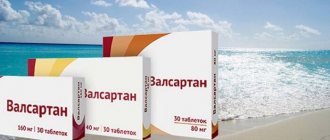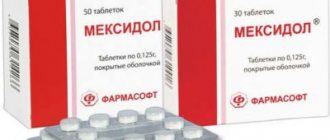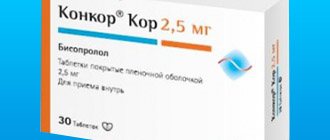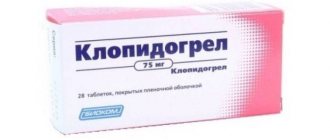Coraxan
It is not recommended to take ivabradine simultaneously with drugs that prolong the QT interval (including quinidine, disopyramide, bepridil, sotalol, ibutilide, amiodarone; pimazide, ziprasidone, sertindole, mefloquine, halofantrine, pentamidine, cisapride, erythromycin IV) - increased the severity of the decrease in heart rate; Drugs that reduce heart rate (diltiazem, verapamil) - increase the concentration of ivabradine by 2-3 times, with an additional decrease in heart rate by 5/min.
Does not have a significant effect on the metabolism and plasma concentrations of other drugs metabolized with the participation of cytochrome CYP3A4.
Inhibitors of cytochrome CYP3A4 increase (the risk of developing severe bradycardia), and inducers reduce plasma concentrations of ivabradine.
Contraindicated combinations: potent cytochrome P450 inhibitors, incl. azole antifungals (ketoconazole, intraconazole), macrolide antibiotics (clarithromycin, oral erythromycin, josamycin, telithromycin), HIV protease inhibitors (nelfinavir, ritonavir) and nefazodone. Ketoconazole (200 mg/day) or josamycin (1 g 2 times a day) increases the average concentration of ivabradine in blood plasma by 7-8 times.
The use of ivabradine with moderate CYP3A4 inhibitors (including fluconazole) should begin with an initial dose of 2.5 mg 2 times a day. If the heart rate is less than 60/min, careful monitoring of heart rate is necessary.
Grapefruit juice increases the concentration of ivabradine in the blood by 2 times.
Inducers of CYP3A4 (rifampicin, barbiturates, phenytoin and herbal preparations containing St. John's wort) - a decrease in the concentration and activity of this drug (the need to use a higher dose of ivabradine).
Proton pump inhibitors (omeprazole, lansoprazole), PED5 inhibitors (sildenafil), HMG-CoA reductase inhibitors (simvastatin), BMCC - dihydropyridine derivatives (amlodipine, lacidipine), digoxin and warfarin do not have a clinically significant effect on the pharmacodynamics and pharmacokinetics of ivabradine.
It does not have a clinically significant effect on the pharmacokinetics and pharmacodynamics of simvastatin, amlodipine, lacidipine, digoxin, warfarin, ASA.
Treatment with the drug can be prescribed in combination with ACE inhibitors, angiotensin II receptor blockers, diuretics, short- and long-acting nitrates, HMG-CoA reductase inhibitors, fibrates, proton pump inhibitors, oral hypoglycemic drugs, ASA and other antiplatelet agents.
Contraindications for use
The use of Coraxan is contraindicated in patients who have:
- Severe liver failure;
- Implantation of an artificial pacemaker;
- Reduced blood pressure;
- Low heart rate;
- Acute myocardial infarction;
- Sinoatrial block;
- Sick sinus syndrome;
- Unstable angina;
- 3rd degree atrioventricular block;
- Chronic heart failure;
- Hypersensitivity to the components of the drug;
- Cardiogenic shock.
In accordance with the instructions, Coraxan is not prescribed to children under 18 years of age, as well as to women during pregnancy and lactation.
Release form, composition and packaging
Orange-pink film-coated tablets, oval, biconvex, notched on both sides, engraved with the company logo on one side and the number “5” on the other.
| 1 tab. | |
| ivabradine hydrochloride | 5.39 mg, |
| which corresponds to the content of ivabradine | 5 mg |
Excipients: lactose monohydrate - 63.91 mg, magnesium stearate - 0.5 mg, corn starch - 20 mg, maltodextrin - 10 mg, colloidal anhydrous silicon dioxide - 0.2 mg.
Film shell composition: glycerol - 0.0874 mg, hypromellose - 1.45276 mg, yellow iron oxide dye (E172) - 0.01457 mg, red iron oxide dye (E172) - 0.00485 mg, macrogol 6000 - 0.09276 mg, magnesium stearate - 0.0874 mg, titanium di oxide (E171) - 0.26026 mg.
14 pcs. - blisters (1) - cardboard packs. 14 pcs. - blisters (2) - cardboard packs. 14 pcs. - blisters (4) - cardboard packs.
The tablets are orange-pink, triangular, film-coated, with the company logo engraved on one side and the number “7.5” on the other.
| 1 tab. | |
| ivabradine hydrochloride | 8.085 mg, |
| which corresponds to the content of ivabradine | 7.5 mg |
Excipients: lactose monohydrate - 61.215 mg, magnesium stearate - 0.5 mg, corn starch - 20 mg, maltodextrin - 10 mg, colloidal anhydrous silicon dioxide - 0.2 mg.
Film shell composition: glycerol - 0.0874 mg, hypromellose - 1.45276 mg, yellow iron oxide dye (E172) - 0.01457 mg, red iron oxide dye (E172) - 0.00485 mg, macrogol 6000 - 0.09276 mg, magnesium stearate - 0.0874 mg, titanium di oxide (E171) - 0.26026 mg.
14 pcs. - blisters (1) - cardboard packs. 14 pcs. - blisters (2) - cardboard packs. 14 pcs. - blisters (4) - cardboard packs.
Overdose
An overdose of Coraxan may be accompanied by severe, prolonged bradycardia, which is poorly tolerated by patients. In this case, symptomatic treatment is prescribed, which is carried out exclusively in specialized hospitals. If bradycardia is combined with unfavorable changes in hemodynamic parameters, symptomatic therapy with intravenous beta-agonists (for example, isoprenaline) is recommended. If necessary, it is possible to temporarily install an artificial pacemaker.
special instructions
Coraxan is not effective in treating or preventing arrhythmias. The effectiveness of the drug decreases with the development of tachyarrhythmia. The drug is not recommended for patients with atrial fibrillation or other types of arrhythmias associated with sinus node function.
During treatment, clinical monitoring of patients should be carried out to identify paroxysmal or persistent atrial fibrillation. For clinical indications (for example, the appearance of a feeling of increased heartbeat, worsening angina pectoris, irregular heart rhythm), an ECG should be included in the routine monitoring process. The risk of atrial fibrillation is usually higher in patients with chronic heart failure taking Coraxan. Atrial fibrillation was more common in patients who were simultaneously taking class I antiarrhythmic drugs or amiodarone.
The condition of patients with intraventricular conduction disorders, chronic heart failure and ventricular dyssynchrony should be kept under close supervision.
The use of Coraxan simultaneously with blockers of slow calcium channels that reduce heart rate (diltiazem, verapamil) is not recommended.
Before starting therapy, the course of heart failure must be stable. Due to limited data, the drug should be used with caution in patients with chronic heart failure of functional class IV according to the NYHA classification.
It is not recommended to prescribe Coraxan immediately after a stroke.
Coraxan affects the function of the retina. No toxic effects of the drug have been identified, but its effect on the retina of the eyes with prolonged use (longer than 1 year) is unknown. If visual impairments not described in these instructions develop, discontinuation of therapy should be considered. Patients with retinal pigmentary degeneration are advised to take Coraxan with caution.
Coraxan can cause a short-term change in light perception (usually in the form of photopsia), which must be taken into account when driving vehicles or other mechanisms, especially at night with a sharp change in light intensity.
pharmachologic effect
Ivabradine is a drug that slows the heart rate, the mechanism of action of which is to selectively and specifically inhibit the If channels of the sinus node, which control spontaneous diastolic depolarization in the sinus node and regulate heart rate.
Ivabradine has a selective effect on the sinus node, without affecting the timing of impulses along the intraatrial, atrioventricular and intraventricular pathways, as well as myocardial contractility and ventricular repolarization.
Ivabradine may also interact with the Ih channels of the retina, similar to the If channels of the heart, which are involved in causing temporary changes in the visual perception system by changing the retinal response to bright light stimuli.
Under provoking circumstances (for example, a rapid change in brightness in the visual field), partial inhibition of Ih channels by ivabradine causes the phenomenon of changes in light perception (photopsia). Photopsia is characterized by a transient change in brightness in a limited area of the visual field.
The main pharmacological feature of ivabradine is its ability to dose-dependently reduce heart rate. An analysis of the dependence of the magnitude of the decrease in heart rate on the dose of the drug was carried out with a gradual increase in the dose of ivabradine to 20 mg 2 times a day and revealed a tendency to achieve a plateau effect (no increase in the therapeutic effect with a further increase in the dose), which reduces the risk of developing severe bradycardia (heart rate less than 40 beats ./min).
When the drug is prescribed in recommended doses, the degree of decrease in heart rate depends on its initial value and is approximately 10-15 beats/min at rest and during physical activity. As a result, the work of the heart decreases and the myocardium’s need for oxygen decreases.
Ivabradine does not affect intracardiac conduction, myocardial contractility (does not cause a negative inotropic effect) or the process of repolarization of the ventricles of the heart. In clinical electrophysiological studies, ivabradine had no effect on the timing of impulses along the atrioventricular or intraventricular pathways, as well as on corrected QT intervals.
In special studies involving patients with left ventricular dysfunction (left ventricular ejection fraction (LVEF) 30-45%), it was shown that ivabradine does not affect myocardial contractility.
It was found that ivabradine at a dose of 5 mg 2 times a day improved the performance of stress tests after 3-4 weeks of therapy. Efficacy was also confirmed for a dose of 7.5 mg 2 times a day. In particular, an additional effect when increasing the dose from 5 mg to 7.5 mg 2 times / day was established in a comparative study with atenolol. The time for performing physical activity increased by approximately 1 min after just 1 month of using ivabradine at a dose of 5 mg 2 times a day, while after an additional 3-month course of taking ivabradine at a dose of 7.5 mg 2 times a day orally, a further increase in this indicator by 25 was noted sec. The antianginal and anti-ischemic efficacy of ivabradine was also confirmed in patients aged 65 years and older.
The effectiveness of ivabradine when used in doses of 5 mg and 7.5 mg 2 times a day was noted in these studies in relation to all indicators of stress tests (total duration of physical activity, time to a limiting attack of angina, time to the onset of an angina attack and time to the development of ST segment depression at 1 mm), and was also accompanied by a decrease in the incidence of angina attacks by approximately 70%. The use of ivabradine 2 times a day provided constant therapeutic efficacy for 24 hours.
In patients taking ivabradine, additional effectiveness of ivabradine was shown in relation to all indicators of stress tests when added to the maximum dose of atenolol (50 mg) at the decline of therapeutic activity (12 hours after oral administration).
There is no improvement in the effectiveness of ivabradine when added to the maximum dose of amlodipine at the decline in therapeutic activity (12 hours after oral administration), while at the maximum of activity (3-4 hours after oral administration), the additional effectiveness of ivabradine has been proven.
In clinical efficacy studies of the drug, the effects of ivabradine were fully maintained over the 3- and 4-month treatment periods. During treatment, there were no signs of the development of tolerance (decreased effectiveness), and after cessation of treatment, no withdrawal syndrome was observed. The antianginal and anti-ischemic effects of ivabradine were associated with a dose-dependent decrease in heart rate, as well as a significant decrease in the work product (heart rate × systolic blood pressure), both at rest and during physical activity. The effect on blood pressure and peripheral vascular resistance was minor and clinically insignificant.
A sustained reduction in heart rate was demonstrated in patients taking ivabradine for at least 1 year (n=713). There was no effect on carbohydrate metabolism and lipid profile.
In patients with diabetes (n=457), the efficacy and safety of ivabradine were similar to those in the general patient population.
There were no differences between the groups of patients taking ivabradine against the background of standard therapy in patients with stable angina and left ventricular dysfunction (LVEF less than 40%), 86.9% of whom received beta-blockers, and placebo, in the total incidence of deaths from cardiovascular diseases , hospitalization for acute myocardial infarction, hospitalization for new cases of heart failure or worsening symptoms of chronic heart failure (hazard ratio 1.00, p = 0.945) and in the subgroup of patients with a heart rate of at least 70 beats/min. (hazard ratio 0.91, p=0.17) (BEAUTIFUL study).
The use of ivabradine in patients with a heart rate of at least 70 beats/min showed a reduction in the frequency of hospitalizations for fatal and non-fatal myocardial infarction by 36% (p=0.001) and the frequency of coronary revascularization by 30% (p=0.016).
In patients with exertional angina pectoris while taking ivabradine, there was a reduction in the relative risk of complications (frequency of deaths from cardiovascular diseases, hospitalization for acute myocardial infarction, hospitalization for new cases of heart failure or increased symptoms of chronic heart failure) by 24 % (p=0.05). The noted therapeutic benefit is achieved primarily by reducing the frequency of hospitalization for acute myocardial infarction by 42% (p = 0.021).
Reducing the frequency of hospitalization for fatal and non-fatal myocardial infarction in patients with heart rate more than 70 beats/min. even more significant and reaches 73% (p = 0.002). In general, the drug was well tolerated and safe.




